Experimental Investigations of the LED Lamp with Heat Sink Inside the Synthetic Jet Actuator
Abstract
1. Introduction
2. Materials and Methods
Data Reduction
3. Results
3.1. Electrical Characteristics
3.2. Temperature Characteristics
3.3. Heat Transfer Characteristics
4. Discussion
4.1. Thermal Resistance Network
4.2. Identification of the Energy Losses
- Losses resulting from the energetic efficiency of the LED driver less than unity. Measured efficiency of the LED driver was equal to 95.8% (see Figure 7a). The LED driver efficiency depends on the technology and the quality of the electronic components used. In fact, the value of the energetic efficiency of 95.7% is quite close to the feasible limit of efficiency improvement for such devices [27].
- Losses in the energy conversion in the LEDs with luminous efficiency taken at 25 °C as well as the losses resulting from the luminous efficiency drop with junction temperature increase over the temperature of 25 °C. The performance of LED diodes mostly depends on the manufacturing technology and the quality of the components used, however, there is some room for improvement in the light conversion efficacy during the design process of a LED lamp. Appropriately adjusted values of the operating parameters, especially the diode junction temperature, may also prove helpful in this regard. LEDs can operate at various values of supply current, which results in different values of luminous efficacy. For example, at a junction temperature equal to 25 °C and forward current equal to 20 mA, the luminous efficacy of the investigated LEDs was equal to 230 lm/W, while with the increase in forward current to 200 mA, the luminous efficacy decreased to 195 lm/W [19]. The losses of energy conversion in LEDs may therefore be reduced by setting a lower value of the supply current. Since the output luminous flux depends strongly on the current value, maintaining the desired flux level in such a case would require an increase in the number of LEDs in a lamp. A higher number of diodes, however, directly increases the production cost of the LED lamp. For the model of the LED used in present paper, the majority of the parameters are provided in the datasheet at the LED junction temperature of TJ = 25°C [19]. With the LED junction temperature increasing from 25 °C to 125 °C and a constant forward current of 65 mA, the relative luminous flux decreased from 100% to 90% [19], thus reducing the luminous efficacy of the LEDs. An efficient cooling system that prevents the excessive increase in the junction temperature is therefore another method for the reduction in energy conversion losses in LEDs.
- Losses of the light transfer through the LED lamp secondary optics. Lu et al. [28] experimentally investigated the color shift and transmittance during temperature aging of two materials widely used as secondary optics in commercial LED lamps: BPA-PC and PMMA. The plates of these materials of the thickness of 3 mm were subjected to thermal aging tests for 3000 h at the temperature of 85 °C. The transmittance spectra of BPA-PC and PMMA ranging from 400 to 800 nm were measured. The transmittance of PMMA was constant and equal to 93% in the investigated spectral range and independent of the aging process, while the BPA-PC transmittance increased with an increasing wavelength from approximately 68% to 74% and decreased during the aging process. Generally, the transmittance of transparent PMMA under normal incidence is approximately 92% [29]. Typical low-iron glass has a transmittance of 90%, while low-iron antireflective glass reaches the transmittance value up to 96% [30]. Low-iron glass with special coatings in the visible light spectrum from 400 to 800 nm achieves a transmittance value up to 97% [31]. The transmittance of the PMMA plate in the investigated lamp was estimated at the value of 90%. Reducing optical losses by using the material of higher transmittance is therefore possible.
- Cooling system energy consumption. With increased power delivered to the SJA, the thermal resistance of the heat sink decreases (see Equation (5)), however, this energy is eventually almost entirely converted into heat, increasing the overall heat flow rate . It is therefore important to tune the cooling system so that it does not require an energy input above the level that is necessary to maintain an adequately low junction temperature. Although this depends on the desired lifetime of the LED lamp, it may prove beneficial to increase the energy used to drive the cooling system, if the resulting decrease in the junction temperature will bring a significant gain in terms of the lifetime of the LEDs.
5. Conclusions
Author Contributions
Funding
Data Availability Statement
Conflicts of Interest
Nomenclature
| f | Frequency | (Hz) |
| h | Heat transfer coefficient | (W/(m2·°C)) |
| ILED_AC | Effective current of the LED driver | (A) |
| ILED_DC | DC current of the LED driver | (A) |
| ILS_AC | Effective current supplying SJA | (A) |
| PLED_AC | Real AC power of the LED driver | (W) |
| PLED_DC | DC power of the LED driver | (W) |
| PLS | Real power delivered to SJA | (W) |
| POPT | Light radiant power | (W) |
| q | Heat flux | (W/m2) |
| Heat flow rate | (W) | |
| R | Thermal resistance | (°C/W) |
| S | Surface area | (m2) |
| T | Temperature | (°C) |
| T∞ | Ambient temperature | (°C) |
| TJ | LED junction temperature | (°C) |
| TPCB | Average temperature on the PCB | (°C) |
| TS | LED solder point temperature | (°C) |
| ULED_AC | LED driver effective AC voltage | (V) |
| ULED_DC | LED driver DC voltage | (V) |
| ULS_AC | Effective voltage supplying SJA | (V) |
| φ | Phase shift | (-) |
| Subscripts | ||
| A | Surface A | |
| B | Surface B | |
| C | Surface C | |
| D | Surface D | |
| Abbreviations | ||
| AC | Alternating current | |
| DC | Direct current | |
| IR | Infrared | |
| LED | Light-emitting diode | |
| PCB | Printed circuit board | |
| SJ | Synthetic jet | |
| SJA | Synthetic jet actuator | |
| SMD | Surface mounted device |
References
- Alstone, P.; Jacobson, A. LED Advances Accelerate Universal Access to Electric Lighting. Comptes Rendus Phys. 2018, 19, 146–158. [Google Scholar] [CrossRef]
- Pimputkar, S.; Speck, J.S.; DenBaars, S.P.; Nakamura, S. Prospects for LED lighting. Nat. Photonics 2009, 3, 180–182. [Google Scholar] [CrossRef]
- Nakamura, S.; Fasol, G. The Blue Laser Diode: GaN Based Light Emitters and Lasers; Springer Science & Business Media: Berlin/Heidelberg, Germany, 2013. [Google Scholar]
- Morgan Pattison, P.; Hansen, M.; Tsao, J.Y. LED Lighting Efficacy: Status and Directions. Comptes Rendus Phys. 2018, 19, 134–145. [Google Scholar] [CrossRef]
- Lisitsyn, V.M.; Lukash, V.S.; Stepanov, S.A.; Yangyang, J. White LEDs with Limit Luminous Efficacy. AIP Conf. Proc. 2016, 1698, 060008. [Google Scholar] [CrossRef]
- Tsao, J.Y. Solid-state lighting: Lamps, chips, and materials for tomorrow. IEEE Circuits Devices Mag. 2004, 20, 28–37. [Google Scholar] [CrossRef]
- Ishizaki, S.; Kimura, H.; Sugimoto, M. Lifetime estimation of high power white LEDs. J. Light Vis. Environ. 2007, 31, 11–18. [Google Scholar] [CrossRef]
- Wang, F.K.; Chu, T.P. Lifetime Predictions of LED-Based Light Bars by Accelerated Degradation Test. Microelectron. Reliab. 2012, 52, 1332–1336. [Google Scholar] [CrossRef]
- Wang, F.K.; Lu, Y.C. Useful Lifetime Analysis for High-Power White LEDs. Microelectron. Reliab. 2014, 54, 1307–1315. [Google Scholar] [CrossRef]
- Smyk, E.; Gil, P.; Gałek, R.; Przeszłowski, Ł. Comparison of the Axial Fan and Synthetic Jet Cooling Systems. Appl. Sci. 2022, 12, 4349. [Google Scholar] [CrossRef]
- Dutkowski, K.; Kruzel, M.; Rokosz, K. Review of the State-of-the-Art Uses of Minimal Surfaces in Heat Transfer. Energies 2022, 15, 7994. [Google Scholar] [CrossRef]
- Shen, Q.; Sun, D.; Xu, Y.; Jin, T.; Zhao, X. Orientation Effects on Natural Convection Heat Dissipation of Rectangular Fin Heat Sinks Mounted on LEDs. Int. J. Heat Mass Transf. 2014, 75, 462–469. [Google Scholar] [CrossRef]
- Jeong, M.W.; Jeon, S.W.; Kim, Y. Optimal Thermal Design of a Horizontal Fin Heat Sink with a Modified-Opening Model Mounted on an LED Module. Appl. Therm. Eng. 2015, 91, 105–115. [Google Scholar] [CrossRef]
- Jang, D.; Yu, S.H.; Lee, K.S. Multidisciplinary Optimization of a Pin-Fin Radial Heat Sink for LED Lighting Applications. Int. J. Heat Mass Transf. 2012, 55, 515–521. [Google Scholar] [CrossRef]
- Markowicz, M.; Smyk, E.; Smusz, R. Experimental Study of the LED Lamp. MATEC Web Conf. 2021, 338, 01015. [Google Scholar] [CrossRef]
- Smith, B.L.; Glezer, A. The Formation and Evolution of Synthetic Jets. Phys. Fluids 1998, 10, 2281–2297. [Google Scholar] [CrossRef]
- Mangate, L.D.; Chaudhari, M.B. Experimental Study on Heat Transfer Characteristics of a Heat Sink with Multiple-Orifice Synthetic Jet. Int. J. Heat Mass Transf. 2016, 103, 1181–1190. [Google Scholar] [CrossRef]
- Gil, P. Experimental Investigation on Heat Transfer Enhancement of Air-Cooled Heat Sink Using Multiple Synthetic Jets. Int. J. Therm. Sci. 2021, 166, 106949. [Google Scholar] [CrossRef]
- Seoul Semiconductor, Mid Power 3030 Series, LED STW8C12C-E0 Model Datasheet; Seoul Semiconductor: Seoul, Republic of Korea.
- Keppens, A.; Ryckaert, W.R.; Deconinck, G.; Hanselaer, P. High Power Light-Emitting Diode Junction Temperature Determination from Current-Voltage Characteristics. J. Appl. Phys. 2008, 104, 093104. [Google Scholar] [CrossRef]
- Iero, D.; Merenda, M.; Carotenuto, R.; Pangallo, G.; Rao, S.; Brezeanu, G.; Della Corte, F.G. A Technique for Improving the Precision of the Direct Measurement of Junction Temperature in Power Light-Emitting Diodes. Sensors 2021, 21, 3113. [Google Scholar] [CrossRef] [PubMed]
- Iso, I.; OIML, B. Guide to the Expression of Uncertainty in Measurement; JCGM: Geneva, Switzerland, 1995. [Google Scholar]
- Huang, M.; Yang, L. Heat Generation by the Phosphor Layer of High-Power White LED Emitters. IEEE Photonics Technol. Lett. 2013, 25, 1317–1320. [Google Scholar] [CrossRef]
- NICHA. Application Note: Thermal Design Considerations for the Nichia NCSxE17A or NVSxE21A LEDs, SP-QR-C2-210738-1, Sep. 1; NICHA: Wuwei, China, 2021. [Google Scholar]
- Ngo, I.L.; Jang, H.; Byon, C.; Lee, B.J. Experimental Study on Thermal Performance of SMD-LED Chips under the Effects of Electric Wire Pattern and LED Arrangement. Int. J. Heat Mass Transf. 2018, 127, 746–757. [Google Scholar] [CrossRef]
- Gil, P.; Smyk, E.; Gałek, R.; Przeszłowski, Ł. Thermal, Flow and Acoustic Characteristics of the Heat Sink Integrated inside the Synthetic Jet Actuator Cavity. Int. J. Therm. Sci. 2021, 170, 107171. [Google Scholar] [CrossRef]
- Yadlapalli, R.T.; Narasipuram, R.P.; Kotapati, A. An Overview of Energy Efficient Solid State LED Driver Topologies. Int. J. Energy Res. 2020, 44, 612–630. [Google Scholar] [CrossRef]
- Lu, G.; Yazdan Mehr, M.; Van Driel, W.D.; Fan, X.; Fan, J.; Jansen, K.M.B.; Zhang, G.Q. Color Shift Investigations for LED Secondary Optical Designs: Comparison between BPA-PC and PMMA. Opt. Mater. 2015, 45, 37–41. [Google Scholar] [CrossRef]
- Thirumala Patil, M.; Lakshminarasimhan, S.N.; Santhosh, G. Optical and Thermal Studies of Host Poly (Methyl Methacrylate) (PMMA) Based Nanocomposites: A Review. Mater. Today Proc. 2021, 46, 2564–2571. [Google Scholar] [CrossRef]
- Giovannetti, F.; Föste, S.; Ehrmann, N.; Rockendorf, G. High Transmittance, Low Emissivity Glass Covers for Flat Plate Collectors: Applications and Performance. Sol. Energy 2014, 104, 52–59. [Google Scholar] [CrossRef]
- Stapiński, T.; Marszałek, K.; Lipiński, M.; Panek, P.; Szczepanik, W. Investigations of solar panels with anhanced transmission glass. Microelectron. Mater. Technol. 2012, 231, 285–296. [Google Scholar]
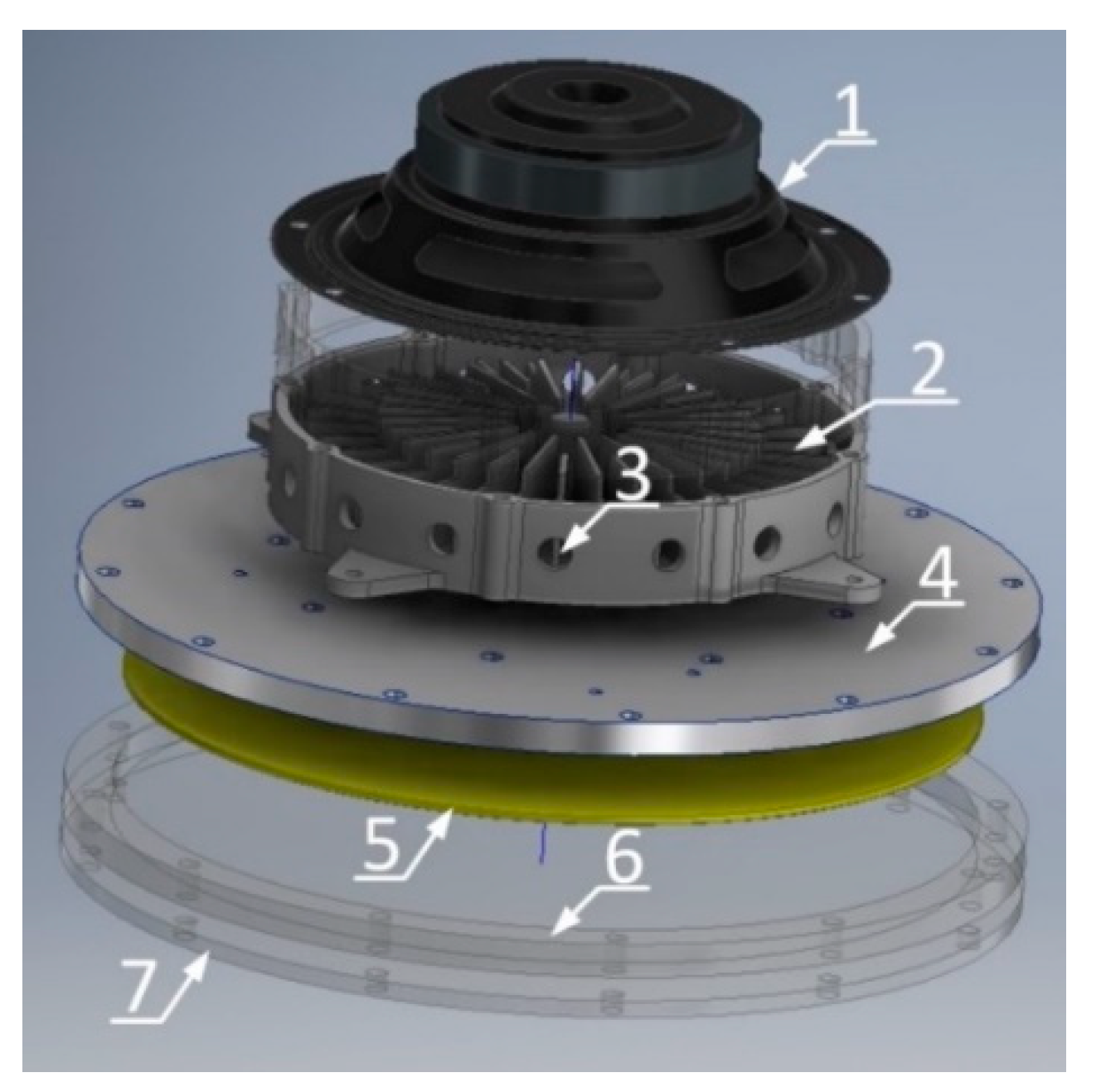
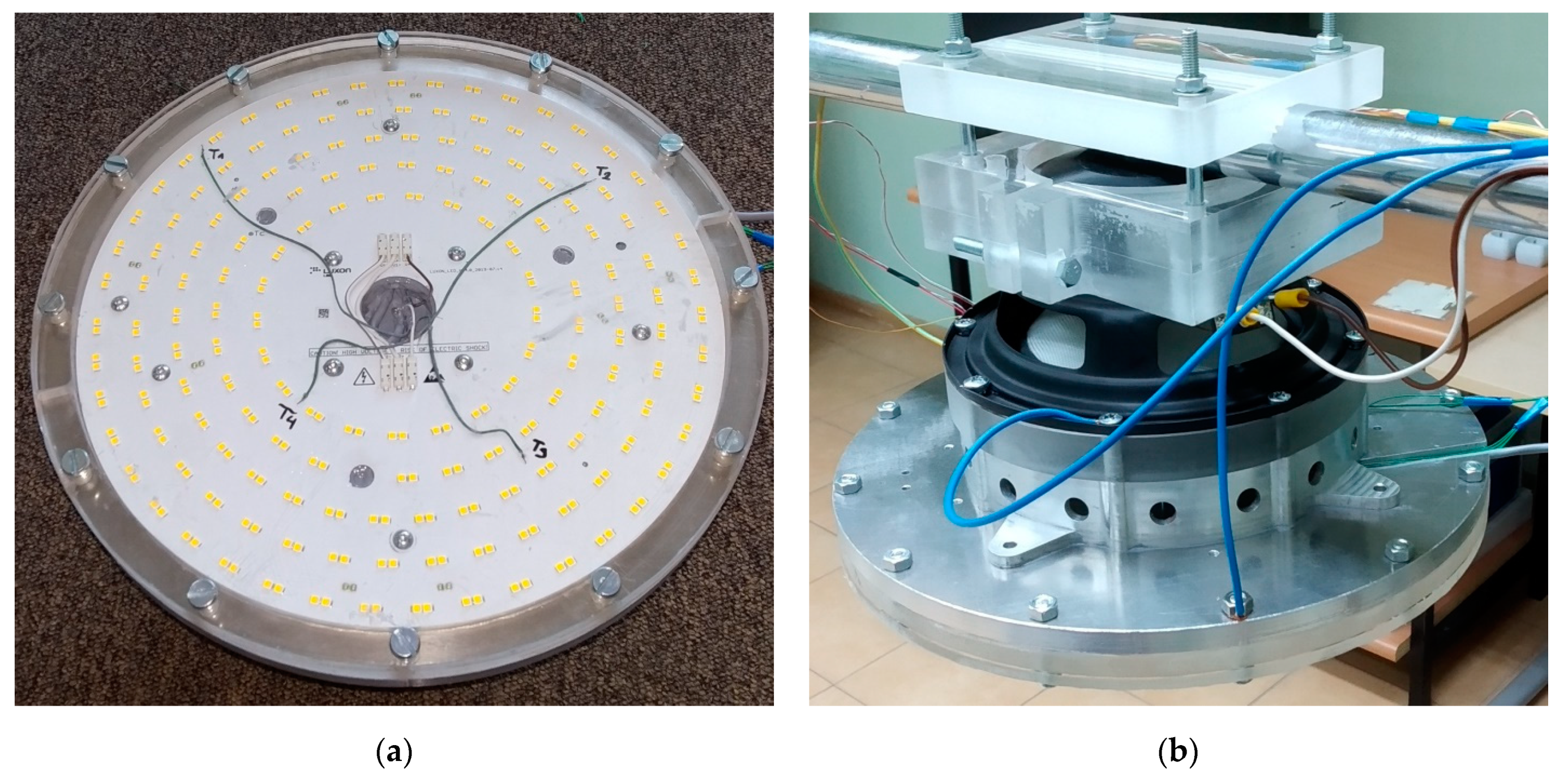


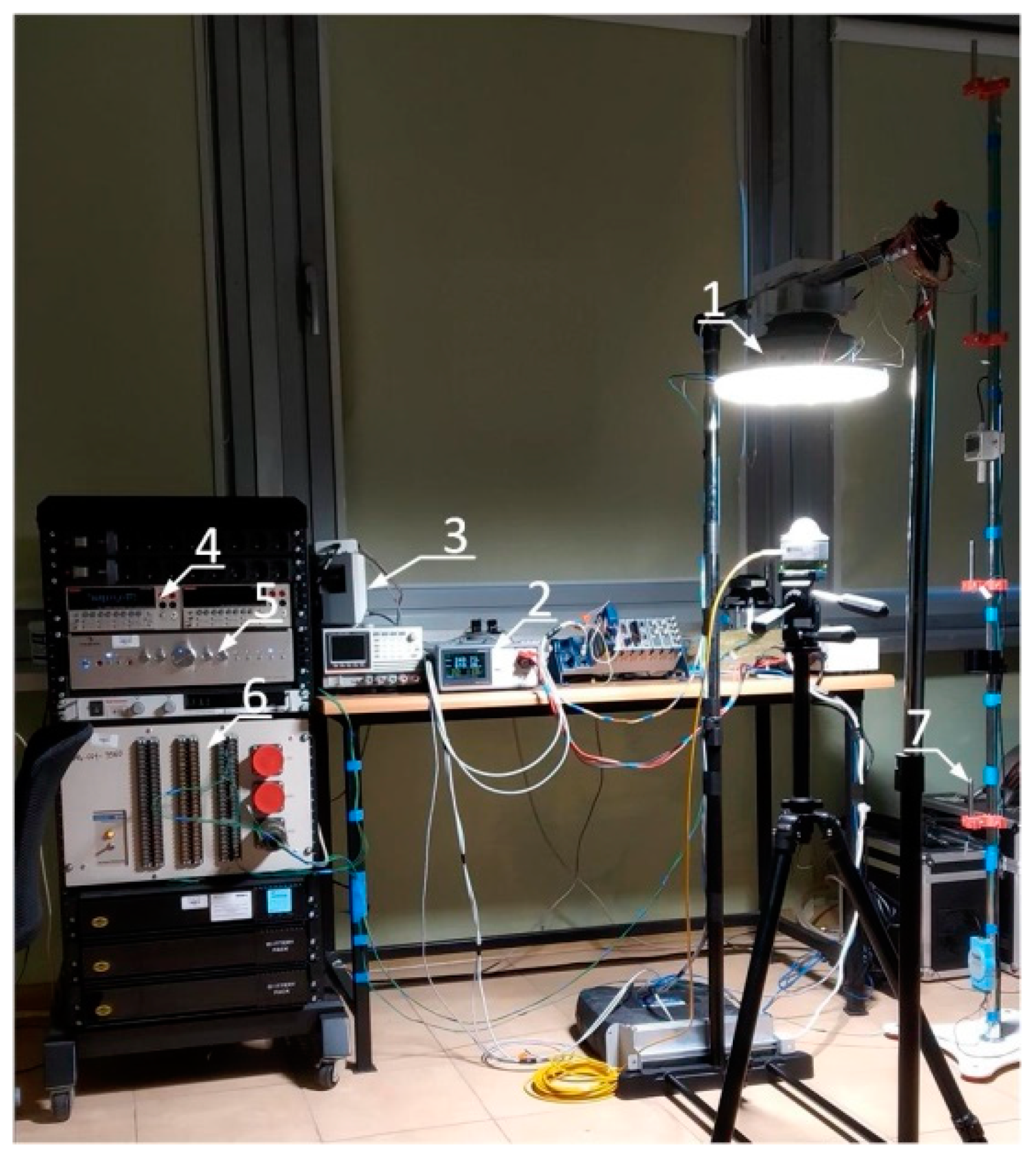

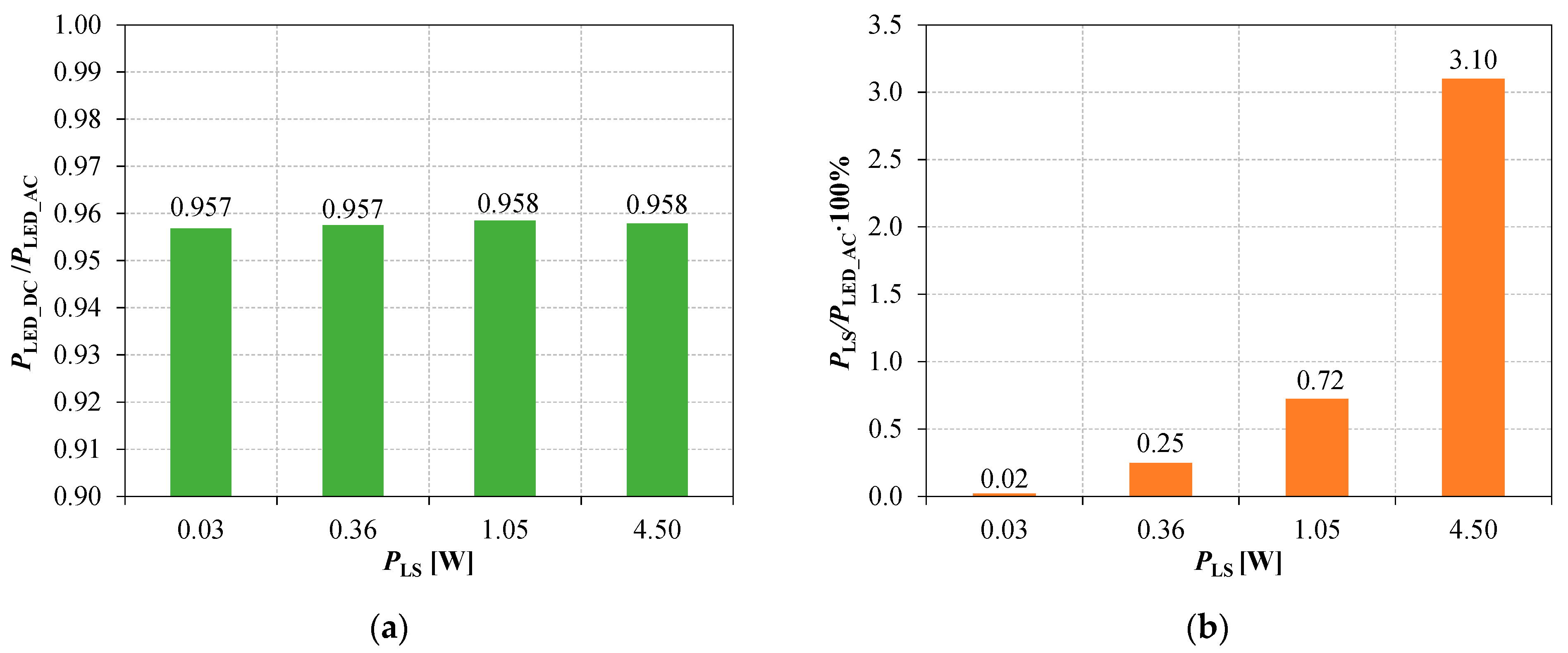
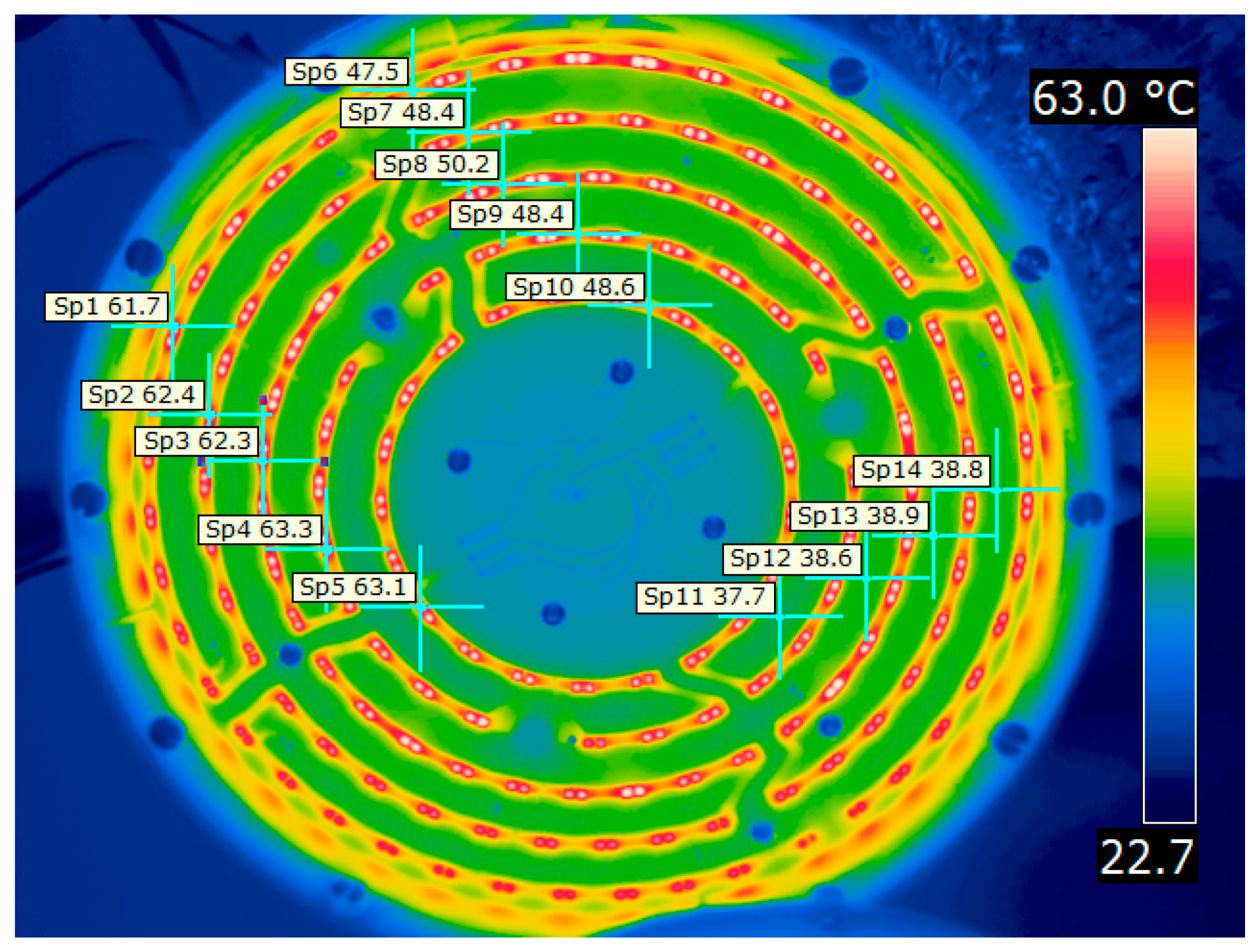
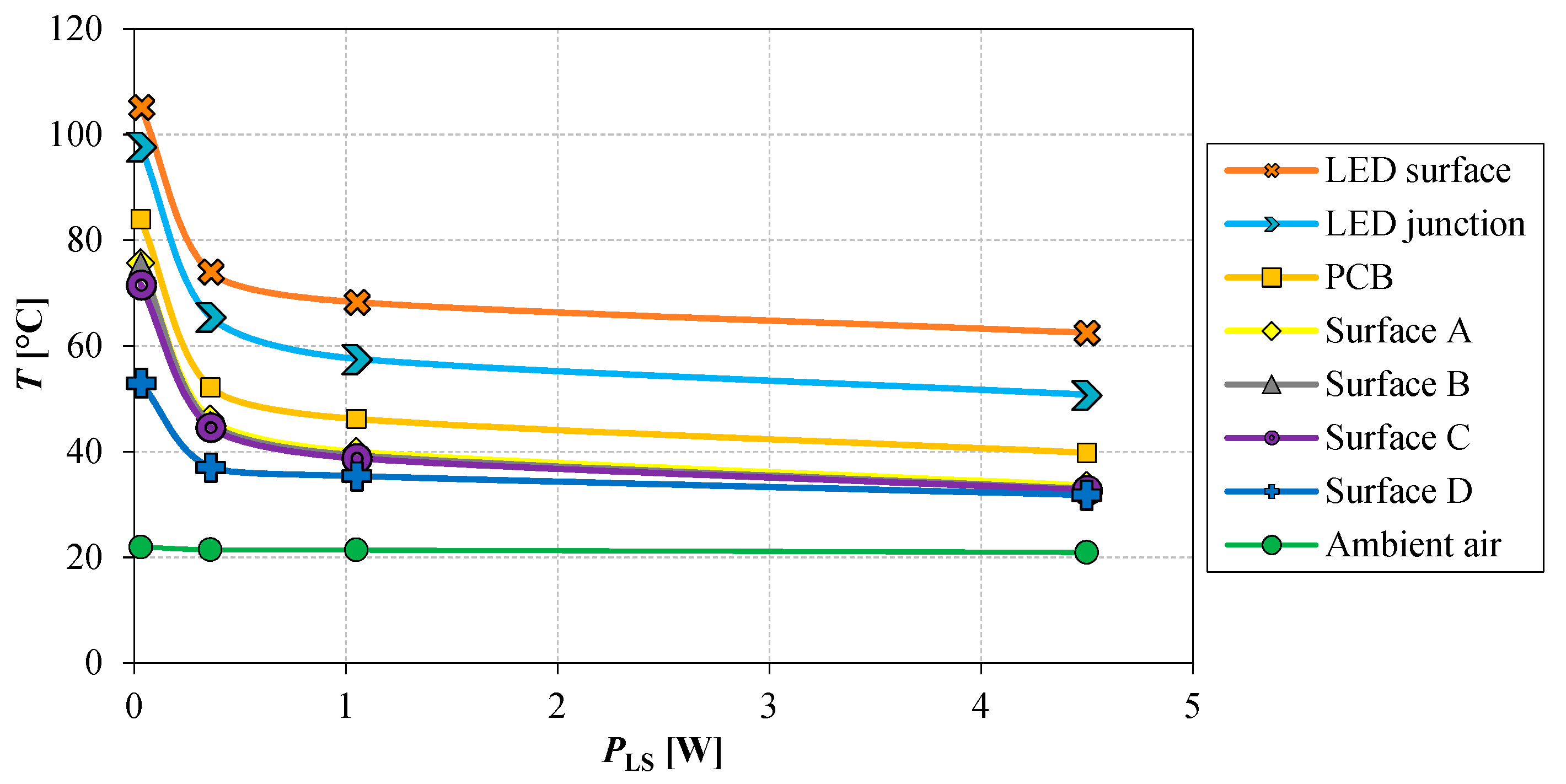

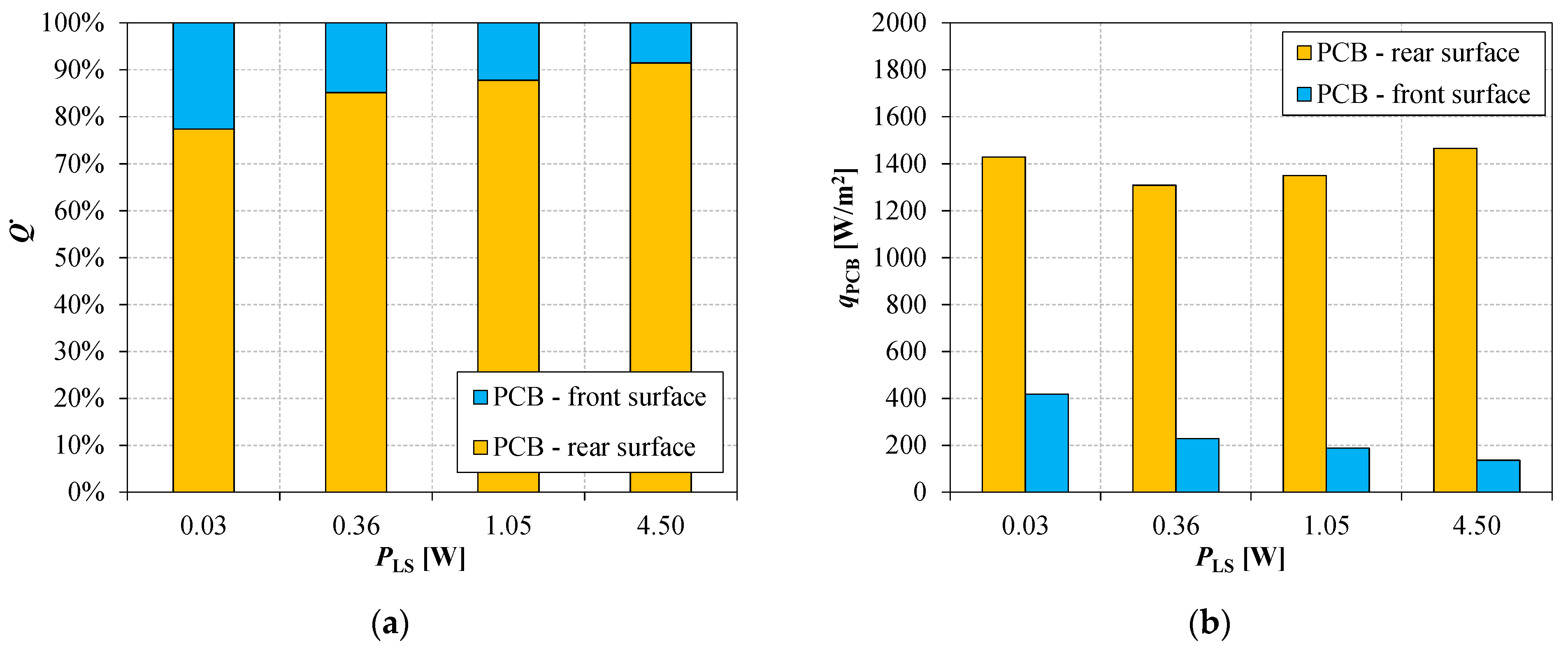
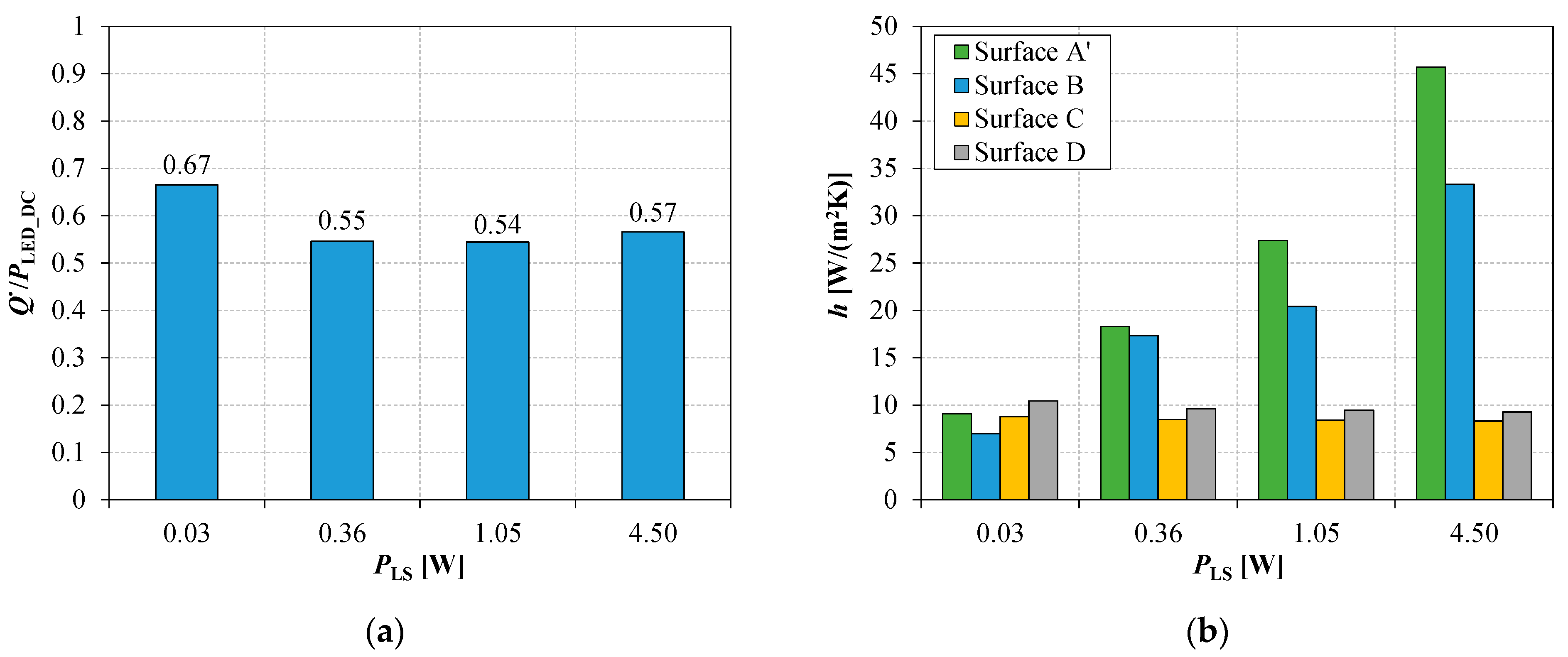
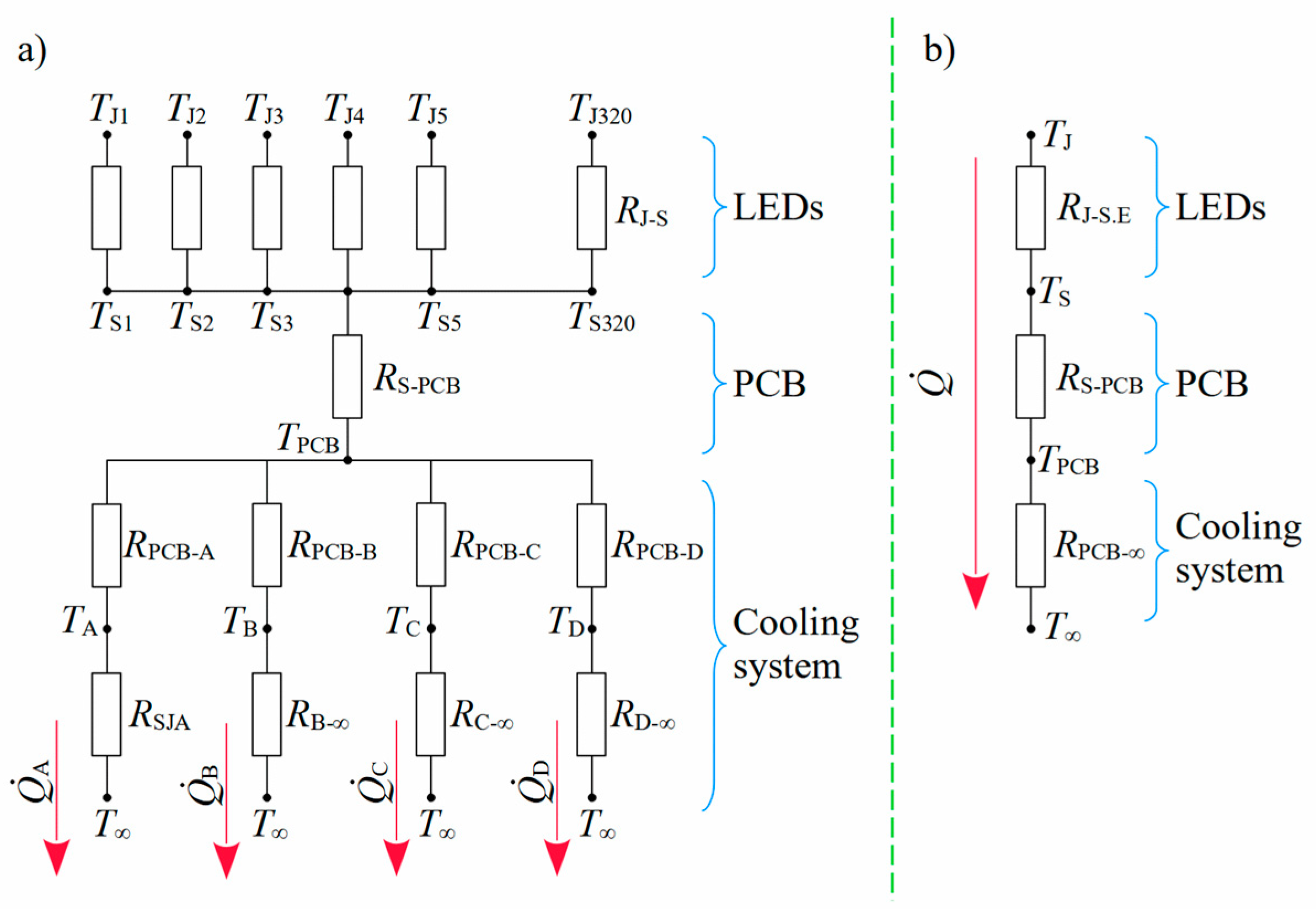


| Name | Relative Uncertainty | Absolute Uncertainty |
|---|---|---|
| T | - | ±0.5 °C |
| T (IR camera) | - | ±2 °C |
| q | ±5.5% | - |
| S | ±1.0% | - |
| ±7.5% | - | |
| h | ±9.0% | - |
| PLED_AC | ±0.80% | - |
| PLED_DC | ±0.30% | - |
| PLS | ±0.55% | - |
| PLED_DC [W] | PLS [W] | PLED_DC + PLS [W] | |
|---|---|---|---|
| 138.5 | 4.44 | 142.94 | 137.0 |
| 137.7 | 1.06 | 138.76 | 133.9 |
Publisher’s Note: MDPI stays neutral with regard to jurisdictional claims in published maps and institutional affiliations. |
© 2022 by the authors. Licensee MDPI, Basel, Switzerland. This article is an open access article distributed under the terms and conditions of the Creative Commons Attribution (CC BY) license (https://creativecommons.org/licenses/by/4.0/).
Share and Cite
Gil, P.; Wilk, J.; Smolen, S.; Gałek, R.; Markowicz, M.; Kucharski, P. Experimental Investigations of the LED Lamp with Heat Sink Inside the Synthetic Jet Actuator. Energies 2022, 15, 9402. https://doi.org/10.3390/en15249402
Gil P, Wilk J, Smolen S, Gałek R, Markowicz M, Kucharski P. Experimental Investigations of the LED Lamp with Heat Sink Inside the Synthetic Jet Actuator. Energies. 2022; 15(24):9402. https://doi.org/10.3390/en15249402
Chicago/Turabian StyleGil, Paweł, Joanna Wilk, Slawomir Smolen, Rafał Gałek, Marek Markowicz, and Piotr Kucharski. 2022. "Experimental Investigations of the LED Lamp with Heat Sink Inside the Synthetic Jet Actuator" Energies 15, no. 24: 9402. https://doi.org/10.3390/en15249402
APA StyleGil, P., Wilk, J., Smolen, S., Gałek, R., Markowicz, M., & Kucharski, P. (2022). Experimental Investigations of the LED Lamp with Heat Sink Inside the Synthetic Jet Actuator. Energies, 15(24), 9402. https://doi.org/10.3390/en15249402







